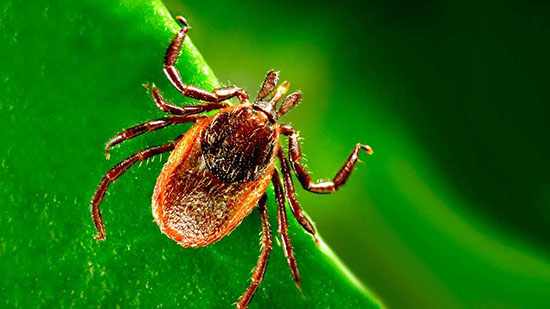-
Taking care of a tick bite

Most tick bites are painless and cause only minor signs and symptoms, such as redness, swelling or a sore on the skin. But some ticks transmit bacteria that cause illnesses, including Lyme disease and Rocky Mountain spotted fever. In general, to transmit Lyme disease a tick needs to be attached for at least 36 hours. Other infections can be transferred in a few hours or even a few minutes.
To take care of a tick bite
- Remove the tick promptly and carefully. Use fine-tipped forceps or tweezers to grasp the tick as close to your skin as possible. Gently pull out the tick using a slow and steady upward motion. Avoid twisting or squeezing the tick. Don't handle the tick with bare hands. Experts don't recommend using petroleum jelly, fingernail polish or a hot match to remove a tick.
- If possible, seal the tick in a container. Put the container in a freezer. Your doctor may want to see the tick if you develop new symptoms.
- Wash your hands and the bite site. Use warm water and soap, rubbing alcohol, or an iodine scrub.
When to seek emergency care
Call 911 or your local emergency number if you develop:
- A severe headache
- Difficulty breathing
- Paralysis
- Heart palpitations
When to contact your health care provider
- You aren't able to completely remove the tick. The longer the tick remains attached to your skin, the greater your risk of getting a disease from it.
- The rash gets bigger. A small red bump may appear at the site of the tick bite. This is normal. But if it develops into a larger rash, perhaps with a bull's-eye pattern, it may indicate Lyme disease. The rash usually appears within three to 14 days. Also consult your doctor if signs and symptoms disappear because you may still be at risk of the disease. Your risk of contracting a disease from a tick bite depends on where you live or travel to, how much time you spend outside in woody and grassy areas, and how well you protect yourself.
- You develop flu-like signs and symptoms. Fever, chills, fatigue, muscle and joint pain, and a headache may accompany the rash.
- You think the bite site is infected. Signs and symptoms include redness or oozing.
- You think you were bitten by a deer tick. You may need antibiotics.
This article is written by Mayo Clinic Staff. Find more health and medical information on mayoclinic.org.
________________________________________________
Related articles:
Mayo Clinic Minute: Avoid ticks
Mayo Clinic Minute: Tips to best remove ticks
Learn the ABCs of Ticks with Dr. Bobbi Pritt







